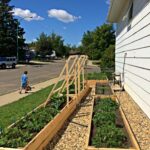A side yard garden is a great way to maximize the space in your outdoor area and add a touch of greenery to your home. Whether your side yard is narrow or wide, there are many ways to transform it into a beautiful and functional garden space.
One of the benefits of a side yard garden is that it can provide a sense of privacy and seclusion. By planting tall trees or shrubs along the perimeter of your yard, you can create a natural barrier that blocks out views from neighbors and passersby. This can make your side yard a peaceful oasis where you can relax and unwind after a long day.
Another advantage of a side yard garden is that it can add beauty and curb appeal to your home. By carefully selecting plants and flowers that complement the style and architecture of your house, you can create a cohesive and visually appealing outdoor space. Consider adding a mix of perennial flowers, ornamental grasses, and evergreen shrubs to ensure that your garden looks attractive year-round.
In addition to being aesthetically pleasing, a side yard garden can also be functional. You can use this space to grow your own fruits and vegetables, creating a small edible garden that provides fresh produce for your household. Raised beds or container gardening are great options for side yards with limited space, allowing you to grow a variety of crops in a compact area.
When designing a side yard garden, it’s important to consider the amount of sunlight that the area receives. Take note of where the sun hits your yard at different times of the day and choose plants accordingly. If your side yard is mostly shaded, opt for shade-loving plants like hostas, ferns, and impatiens. If it receives full sun, select sun-loving plants such as roses, lavender, and herbs.
Finally, a side yard garden can also be a great opportunity to incorporate environmentally friendly practices into your outdoor space. Consider installing a rain barrel to collect rainwater for watering your plants, or creating a compost bin to recycle kitchen scraps and yard waste into nutrient-rich soil for your garden. By making these small changes, you can reduce your environmental footprint and create a more sustainable garden space.
















